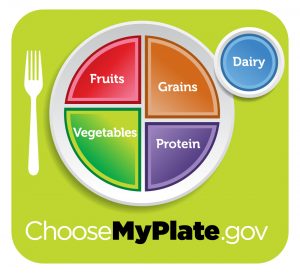Understanding The Food Pyramid Guide
 In June 2011, the United States Department of Agriculture (USDA), in conjunction with First Lady Michelle Obama, launched a new generation version of daily food guidelines called MyPlate, which was designed to prompt consumers to think about building a healthy plate of food at mealtime.
In June 2011, the United States Department of Agriculture (USDA), in conjunction with First Lady Michelle Obama, launched a new generation version of daily food guidelines called MyPlate, which was designed to prompt consumers to think about building a healthy plate of food at mealtime.
MyPlate, which emphasizes the fruit, vegetable, grains, protein and dairy food groups, replaced the USDA’s well-known Food Pyramid Guide that had been in existence since 1992.
The Purpose Behind A New Icon
The MyPlate icon illustrates a plate with the five food groups on a placement that is suggestive of the most appropriate portions of food people should eat at each meal. In particular, MyPlate emphasizes that fruits and vegetables should make up half of a plate at each meal.
The development of MyPlate stemmed from a 2010 report from the White House Childhood Obesity Task Force, which challenged the USDA to design a new symbol as a way to inspire people to choose healthier foods. The goal was to create something simpler and more direct than the existing Food Pyramid Guide at the time.
Key Takeaways of MyPlate
Through the use of MyPlate, the USDA is encouraging people to make changes to their eating habits in three main areas:
Balancing Calories
- Enjoy your food, but eat less.
- Avoid oversized portions.
Foods to Increase
- Make half of your plate fruits and vegetables.
- Make at least half of your grains whole grains.
- Switch to fat-free or low-fat (1 percent) milk.
Foods to Reduce
- Compare sodium in foods like soup, bread and frozen meals, and choose the foods with lower numbers.
- Drink water instead of sugary drinks.
For more information about MyPlate, log onto www.ChooseMyPlate.gov.
Source: ChooseMyPlate.gov
 Eating Disorder Self Test. Take the EAT-26 self test to see if you might have eating disorder symptoms that might require professional evaluation. All answers are confidential.
Eating Disorder Self Test. Take the EAT-26 self test to see if you might have eating disorder symptoms that might require professional evaluation. All answers are confidential.